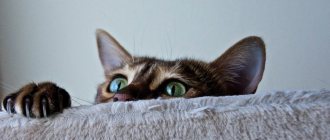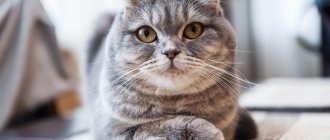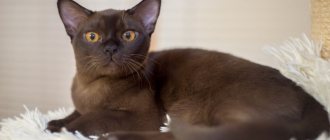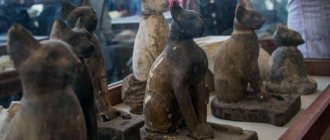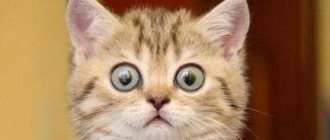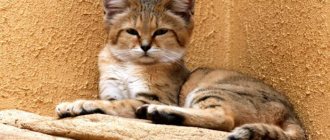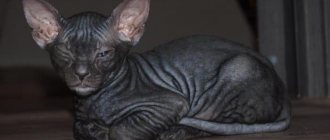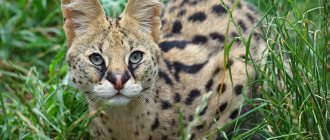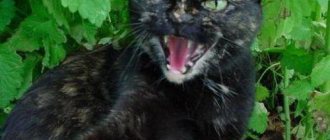The Norwegian Forest is an attractive semi-longhaired cat that combines physical strength, an energetic temperament and a gentle disposition. The playful owner of a thick, luxurious fur coat is not prone to destructive mischief and easily adapts to apartment conditions.
To make living together with a native of the harsh Scandinavian forests comfortable, it is better to find out in advance what the specifics of this breed are.
Brief history of the breed
From the name it becomes clear that Norway is considered the homeland of fluffy forest cats. But with the origin of the breed, not everything is so obvious. Some experts are sure that the ancestors of the animals were long-haired Angora cats brought by the Crusaders.
Others believe that Norwegian Foresters are direct descendants of Viking ship rat-catchers. Still others believe that the breed has deeper roots. In their opinion, the ancestor of these animals is the wild forest cat, common on the European continent.
Norwegian forestry became widely known after an exhibition held in 1938 in Oslo. From that moment, felinologists began serious work on the phenotype of the breed, the goal of which was to consolidate the best qualities and eradicate undesirable traits.
After World War II, the Norwegian forest species became endangered. The breed was saved only thanks to the efforts of caring enthusiasts. Norway received official recognition in 1977.
Health
As has been said many times, these cats are healthy and strong. But, in some lines of Norwegian cats, a hereditary genetic disease transmitted by a recessive gene may occur: Andersen's disease or glycogenosis.
This disease is expressed in a violation of liver metabolism, which leads to cirrhosis. Typically, kittens that inherit both genes from their parents are stillborn or die shortly after birth.
Less commonly, they survive and live from the age of 5 months, after which their condition rapidly deteriorates and they die.
In addition, forest cats have a deficiency of pyruvate kinase (Erythrocyte Pyruvate Kinase Deficiency) and this is a genetic autogenous recessive disease.
The consequence is a decrease in red blood cells, which leads to anemia. In Western countries, the practice of genetic analysis is widespread in order to remove cats and cats that are carriers of these genes from the breeding program.
Interesting Facts
During the existence of the breed, many interesting things have been associated with it:
- Norwegian forest cats are capable of expert tree climbing. Unlike most of their brothers, they descend from there like squirrels, upside down.
- Descriptions of huge fluffy cats, similar to modern representatives of the breed, are found in Scandinavian mythology and medieval literature. It is believed that the Norwegians were the favorites of the goddess Freya. According to legend, they drove her chariot.
- In 1977, King Olaf V decreed that the Norwegian Forest cat be the national cat of Norway.
Description of the breed
When owners of Norwegian cats are asked to describe their pet, breeders begin to talk about the calm character and aristocratic manners of the animal. Forest cats are smart and unpretentious, so they are suitable for indoor keeping. However, like representatives of any other breed, Norwegian cats are characterized by peculiarities in appearance.
The appearance of a Norwegian cat is difficult to confuse with the appearance of representatives of other breeds
My Mira is sociable and appreciates people's attention. If I enter the room where she is sleeping, I immediately hear a loud purring, although outwardly she may not move. The Norwegian Forest purr is really very loud, you can hear it in the next room. But she meows infrequently, only when she feels that feeding time has come, but she has forgotten about it. Only then does she begin to resent my forgetfulness.
Margocha58, forum visitor
https://otzovik.com/review_2564777.html
Appearance
Forest cats have a triple coat (this differs from many other breeds):
- undercoat (thick, “downy” hairs, like cotton wool);
- main coat (the back, sides, and top of the tail are especially densely covered with fur);
- outer coat (the longest, shiny hair along the ridge and tail, which has a water-repellent effect).
Norwegian cats have evenly furred tails
In addition to the fact that the cat seems large due to its fluffy hair, it also weighs a lot. Males can weigh up to 10 kilograms (females slightly less). The body of such a cat is long and massive, the front legs are shorter than the hind legs. The animal's limbs are heavy and its feet are wide. Tufts of fur stick out between the fingers. The tail of the Norwegian cat is long (the length of the tail is equal to the length of the body), almost evenly pubescent to the tip. Norwegian cats have a narrow head to the chin with well-developed cheekbones. The nose is long and straight. The ears are set high on the head and wide at the base. In general, these cats have large and mobile ears, and at their tips there are tassels that start from the inside. The eyes of a forest cat can be of any color, but their distinctive feature is their shape. These are almond-shaped, wide-set eyes (wide, narrowed on the outside).
Unlike some breeds, the color of the Norwegian cat can be almost any color. The exception is the color with shaded paws, ears and muzzles. A Nordic pet cannot look like a Siamese or Thai cat.
The drawing of forest cats is clear and expressive. A characteristic feature of the Norwegian is the “tie”. It is a lighter shade than the main coat and has longer hairs (resembling a beard). Some cats have white patches (paws, beard, tassels). The paw pads are the same color as the coat. In addition, some cats have a thin stripe on the nose that matches the main color. Due to their size and fluffiness, Norwegians are sometimes confused with Maine Coons. Therefore, when comparing, you need to take into account all the distinctive characteristics at once, including the non-standard shape of the head and the shape of the eyes.
Character
Big forest cats have a soft and kind character. This breed is one of the most patient and forgiving. Such a cat will not show aggression even if another animal (or child) tries to provoke it. The forest cat will be gentle and attentive towards its owner. The animal will quickly get used to its person, will love and accompany him. The attachment to the owner is due to strong intelligence and kindness. Such cats remain brave, but cheerful throughout their lives. But despite their kindness, Norwegians are hunters. Instincts will manifest themselves in attempts to explore all the most inaccessible places in the house.
Nordic pets bask in the love of their owners thanks to their gentle nature and love of life
They get along with everyone, not only children, but also with dogs, unobtrusive, non-aggressive, self-sufficient cats. The character is calm, Nordic, good health. On a cat forum, one breeder told how her Norwegian cat was lost, found a month later - stuck in an elevator shaft, sat there without food for 35 days, but survived! They pulled him out in a comatose state, but gradually came to his senses.
Vitusik, Regular forum participant
https://mama51.ru/forum/index.php?topic=54420.0
These cats are reserved and cautious with strangers. Of course, natural curiosity will do its job, and the cat will definitely “take a closer look” at the visitor. And if a stranger does not show aggression, then the cat will repeat the behavior of the owners and sit next to the guest. A noble pet can bond with all family members at once. The animal will not care where it is, as long as it is close to its family. They have a hard time being alone. Feeling like a full member of society, the cat will make it clear that she does not like hugs and kisses. But she will happily sit (lie next to her), thanking you for the stroking with loud purrs.
Some owners of Norwegians think that cats repeat their behavior
Norwegian cats do not know how to take revenge. Even if, for example, a child harms a cat, it will not hold a grudge, but will step aside. The ability to adapt to the world around us is manifested in everything. For example, such a cat can live in a private house. Moreover, in the yard she will be cheerful and mischievous, and upon crossing the threshold of the house she will turn into an affectionate aristocrat. Such a pet will not offend other animals. An intelligent animal will immediately understand who else the owner considers to be his fellow tribesman (dog, hamster, turtle, etc.).
Very talkative, when someone scolds her, she immediately runs to complain to someone at home. She works part-time for us instead of an alarm clock, she starts yelling within two minutes, and when it’s a day off, she meows too, but when you tell her that today is a day off, she immediately calms down and goes to bed calmly.
Natalia, forum user
https://mirkoshek.rf/forum/forum2/topic74/
One of the rare features of the Norwegian cat is the ability to descend from a tree upside down in a spiral (like a squirrel). Forest cat babies have a rare ability (when their mother drags them from place to place, they grab onto their parent with their paws).
Character and temperament
Norwegians are calm and friendly cats with a balanced psyche. Representatives of the breed quickly become attached to all family members, without singling out one owner for themselves. Norwegian Foresters love to be petted and scratched, but cannot stand being sat on your lap.
An important characteristic of cats of this breed is their innate pride. Norwegian Foresters need a personal space where they can retire. At such moments, they do not like it when a game is forced on them.
Due to this character trait, the Norwegian Forest Cat is not able to get along with small children. But she gets along well with older kids who understand how to properly communicate with a pet.
Norwegians live peacefully with their relatives and non-aggressive dogs. But cats of this breed perceive rodents and birds as prey. Therefore, it is not recommended to keep Norwegian forest animals together with small animals such as hamsters or canaries.
Popularity of the breed
Due to the high competition in the group of semi-longhair cats, Norwegians cannot earn an exhibition rating. The main competitors are Siberian cats and Maine Coons. Most often, Norwegians participate in FIFA shows. Most animals live in Scandinavia and Germany.
An interesting story about one of the Norwegians begins in 2000, when the Belgian designer Seppe Slabbinck bought a kitten of this breed, but was forced to urgently leave on business the very next day.
He did not want to leave the baby to strangers so much that he simply put her in his pocket and calmly went about his business. From this day on, the tradition of joint trips and visiting various events stretched for many years. Seppe took the cat with him to restaurants, where she took her place on a chair next to the owner and never behaved badly and did not receive a single complaint against her.
How to choose the right kitten
It is better to purchase Norwegian Forest from trusted breeders or nurseries that specialize in breeding the breed. By the time of sale, kittens must already have documents confirming their breed and vaccinations.
It is important to pay attention to the behavior of the children and the conditions in which they are kept. Norwegian Forest kittens are larger than most other breeds, and their ears usually have neat tufts.
Healthy babies do not have dirt under their tails or unpleasant smells from their mouths. Cats have clear eyes, fluffy fur, clean ears and smooth skin without scratching or rashes.
On a note. A Norwegian Forest baby should have a soft belly. A hard, swollen belly indicates that the kitten is infected with helminths.
Kitten care
Competent breeders donate Norwegian Forest kittens to a new home no earlier than 12 weeks of age. By this time, the kids are already quite independent.
Three-month-old Norwegians eat many foods, know how to go to the litter box and use a scratching post. New owners can only show the pet where it can eat, sleep and relieve itself. And if you pay him more attention and offer him to play more often, the little Norwegian will sooner adapt to the changed conditions.
In order not to aggravate the stress of the move, at first the kitten is fed what the breeder gave. The diet is selected taking into account the age of the Norwegian Forest:
- up to 6 months – 4-5 times a day;
- 6-12 months – 3 times a day;
- from 12 months – 2 times a day.
Important! Norwegian Forest Kittens are very curious. Therefore, for safety reasons, wires, household chemicals, indoor plants, fragile and small objects are hidden from children. For the same reasons, keep the doors of ovens and washing machines closed.
Breeding
Representatives of any breed that originates in the wild have highly developed instincts for procreation and preservation of offspring. These instincts continue in the home environment. Often domestic cats do not need help with either giving birth or raising kittens. But a lot still depends on the breeder. The owner of a purebred cat must find a suitable partner and ensure mating. Usually the owner of a Norwegian tries to meet his future partner personally. Sometimes you even have to go to another city to do this.
Even a non-professional breeder can cope with breeding Norwegian cats
If the cat is purebred, then the cat must match. And age, I think, is not the main thing, you can be younger, the main thing is that the cat is experienced.
vikatiras, forum regular
https://pro-cats.ru/forum/74–4262–3
Criteria for choosing a partner
Inexperienced cat breeders are looking for equally beautiful partners for their Norwegian cats (often also Norwegian). In this case, only the appearance of the cat is assessed (less often, purebred). But the owner of a potential partner may be more experienced. In this case, the cat may not be provided for mating. Few people would want to mix a titled cat with a non-purebred cat. Therefore, before you start choosing, you need to learn how to evaluate the possibility of mating. The likelihood of consent from the partner’s owners and the health of the offspring depend on this. There are 4 main criteria:
- pedigree;
- appearance;
- color;
- blood type.
The most difficult thing about breeding Norwegians is finding a suitable partner
It is not necessary to look for the ideal representative of the breed, you need to find a suitable partner. The presence of titles and regalia does not guarantee the birth of beautiful, healthy offspring. In order for kittens to be as beautiful as their parents, it is advisable to choose a partner who is as similar as possible to your cat. This may be an individual from the same breeding line. Such an animal can be found from the same breeders where you got your pet. When mating relatives, beautiful kittens should be born (provided that the parents are outstanding representatives of the breed) with a good phenotype. This mating is called inbred.
Some forest cat owners are afraid of related matings, and sometimes it is difficult to find a partner from the same pedigree in the right city. In this case, you can choose a partner based on appearance. It is necessary to evaluate the advantages and disadvantages of appearance (head shape, coat quality, distance between ears, etc.). But this method is convenient to use for those breeders who have already learned to distinguish the characteristics of the breed. If you don’t have such skills yet, you can ask the owners of a potential partner for an assessment sheet. This is especially appropriate if you want to adjust the breed of future kittens. For example, if your cat has weak and slightly dull fur, then the cat’s hair, on the contrary, should be ideal.
If you do not have experience mixing cats with different colors, then you need to look for a partner of the same color as your cat. This will increase the likelihood of having kittens with high-quality color. It is also important to take into account the pattern on the animal’s fur. You cannot mix a marbled specimen with an animal, for example, black and white (bicolor). From such a mixture, kittens of both colors can be born, but the pattern will be of poor quality. Marbled kittens may have black or white spots, and black and white babies may have vague patches of merle color. Such nuances are called color defects. It will be difficult to sell such kittens (but you can give them to friends or keep them for further breeding).
In order for the kittens to turn out beautiful and similar to their mother, it is advisable to look for a partner of the same color as her
Cats can have one of three blood types (A, B and A/b). They also need to be taken into account. Cats with group B can be crossed with any cat. And females with the same blood group cannot be mated with males of group A. If this rule is violated, kittens may be born with a disease such as hemolysis. If a cat with blood type B gives birth to kittens with type A, then the offspring must be taken away from the mother immediately, otherwise they will die (after living only a few hours). The babies will have to be fed artificially for three days. The surviving kittens will not be able to become champions of the breed, since after illness the tip of their nose will fall off. To avoid such troubles, you need to know your pet's blood type in advance. The corresponding tests can be done in special laboratories (they are not available in every city).
At what age should you give your pet for the first mating?
Full maturation of a Norwegian cat will occur around the age of 5. Therefore, there is no need to try to mate a young cat. But I also don’t want to wait 5 years, so the first mating can be organized in 2–3 years. If a cat lambs before this age, then its growth and development may “freeze.” She will not grow any further, which means she will look much smaller than her adult relatives. Males can be mated as early as one and a half years old.
A female with a Nordic character will not allow just anyone to approach her. In general, cats of this breed may avoid any communication with other people's animals. But the male, already in adolescence, will “molest” all the cats he finds nearby (including cats of other breeds and outbreds). Kittens can be born beautiful hybrids, but that is not the problem. Someone else's cat (especially a mongrel cat) can infect your cat with some kind of disease. Therefore, a cat that goes outside needs supervision.
Before mating, both individuals must undergo helminthiasis prevention. The procedure for mating a Norwegian cat takes 3–5 days. But even before mating, the owners of both animals can agree on a reward (this is not necessary). If the mating was successful and the cat became pregnant, then the owner of the male is entitled to a kitten from this litter or money (equivalent to the amount of one kitten). Particularly experienced breeders can even enter into written agreements with each other, which will describe in detail all the terms of the transaction.
Video: Norwegian cat courting a female
How often can a cat give birth?
If the owner of the female does not control the frequency of births and does not provide organized mating, then the cat can give birth 3-4 times a year (maximum 5 times). Frequent pregnancy and childbirth can lead to illness in your pet. The fact is that the body of cats that often give birth weakens and does not have time to recover. If there is too little time between births, the following problems may occur:
- weight loss;
- rachiocampsis;
- disturbances in the functioning of the nervous system;
- respiratory tract diseases;
- diseases of the reproductive organs;
- hepatitis, necrosis, etc.
A tired cat has a weakened immune system, which means there is a risk of catching some kind of infection. For these reasons, you should not turn your furry cat into a birthing machine. In addition, mating is an expensive undertaking in itself (sometimes the partner lives in another city). Typically, breeders breed their forest cats 1–2 times a year.
Care and maintenance
Thanks to their thick fur coat, Norwegians can live not only in apartments, but also in private houses with free access to the yard. In general, representatives of the breed are unpretentious to living conditions. And caring for Norwegian forest cats comes down to grooming, trimming claws, brushing teeth, and hygiene of ears and eyes.
The guard cover of representatives of the breed has a special structure and is not prone to the formation of tangles. Therefore, in normal times, the cat is brushed 2-3 times a week. During the molting period, the procedure is carried out daily to speed up the process and give the animal a neat appearance.
The Norwegian Forest coat has a water-repellent layer of fat on it, so it should be bathed as little as possible. Washing a cat of this breed is complicated by the fact that water simply drains from the spine, leaving the fur dry. Therefore, first, a special shampoo for oily wool is rubbed into the Norwegian’s wool, and then it is watered.
The cat's eyes and ears are regularly inspected for any unusual discharge and wiped with a moistened cotton pad.
Norwegian Forest teeth are brushed 2-3 times a month with a silicone brush with a small amount of non-foaming toothpaste. This will help remove plaque and prevent the formation of stones.
The Norwegian Forest Cat's claws are trimmed monthly with a nail clipper. The procedure is carried out as carefully as possible so as not to touch living tissue.
Breed standard
The Norwegian Forest Dog combines amazing flexibility and grace with the powerful physique of a Scandinavian predator. The unusual nature of its exterior makes the animal a desirable participant in many exhibitions, where its external characteristics are assessed on a 100-point scale as follows:
| Parameter | Maximum score | |
| Head | 50 | |
| Nose profile | 10 | |
| Muzzle | 10 | |
| Ears | 10 | |
| Eye shape | 5 | |
| Eye position | 5 | |
| Neck | 5 | |
| Chin | 5 | |
| Body | 30 | |
| Torso | 10 | |
| Paws | 10 | |
| Skeleton | 5 | |
| Tail | 5 | |
| Coat length and texture | 10 | |
| Color | 5 | |
| Harmony | 5 | |
When describing the breed, the greatest attention is paid to the correct physique and structure of the head. But the colors of the animal are so diverse that they are not of great importance when assessing the exterior.
An animal is subject to culling in the following cases:
- pronounced nose break;
- square muzzle;
- pinch on whisker pads;
- elongated rectangular body;
- non-standard number of fingers;
- strabismus;
- defects and breaks in the tail;
- weak bones;
- malocclusion;
- hybrid color.
Body Features
The Norwegian Forest Cat has a strong build and a memorable body shape. Adults reach quite large sizes and weights. The height at the withers reaches 30–40 cm, the weight of males varies from 7 to 10 kg, females - from 5 to 7.
Main characteristics of the body structure:
| Parameter | Peculiarities |
| Frame |
|
| Limbs |
|
| Tail |
|
Structure of the head and muzzle
Characteristics of the main parameters of the head and muzzle of the Norwegian forest cat are presented in the table:
| Parameter | Peculiarities |
| Head |
|
| Neck |
|
| Nose profile |
|
| Forehead |
|
| Chin |
|
| Muzzle |
|
| Eyes |
The color of the iris can be of different shades: from golden-copper, amber and yellow to green. Cats with white markings or light colors may have blue eyes. In some cases, the phenomenon of heterochromia is observed, when the irises are of different colors |
| Ears |
|
Coat properties and colors
The special coat of Norwegian forest cats has the following characteristic features:
- consists of an upper layer, hanging down on the sides, represented by long, smooth and shiny protective hairs with waterproof properties, and a dense undercoat, which becomes significantly denser in the winter;
- the chest coat is divided into three separate sections: a neck collar of short hairs, a front bib and side wavy whiskers;
- There are fluffy “pants” on the hind legs.
A coat with a softer structure is found in cats with a solid, shaded or bicolor color. As for the color itself, a variety of colors and patterns are possible. Any tone of the paw pads, fingers and nose is allowed, not necessarily depending on the base color. In individuals with white patches, the pads may be two-colored or multi-colored. For all colors, the presence of medallions or buttons with a variety of ornaments is also allowed; a reduction in the score is not provided for this.
The most common are solid colors:
| Colors | Short description | Photo |
| White | Solid white glossy color without colored splashes, paw pads and nose tip preferably light pink | |
| Black | A rich coal-black pigment evenly covers the entire surface of the hairs from root to tip, the skin of the paws and nose is preferably black. | |
| Blue | The entire surface of the coat from the muzzle to the tip of the tail is painted in a rich blue tone; the hairs at the base are lighter. Paw pads and nose are preferably blue | |
| Red | Rich red tone of the coat without ticking, shading or patterning. The skin of the paws and nose is preferably brick red in color. | |
| Cream | Coat evenly shaded with a dark yellow tint and without a pattern. The hairs are brighter at the base, and at the tips the color is paler. Light beige tones are preferable to dark ones, the skin of the nose and paw pads and fingers is preferably pink. |
In addition, smoky and multi-colored colors, shaded (silver, golden, cameo, etc.), bicolor, amber, tabby colors with clear and uniform patterns are common.
Cats with colors resulting from hybridization are subject to culling. Disqualifying colors include chocolate, sable, lavender, lilac, brown, as well as fawn, point colors (Himalayan type) and all combinations of these colors with white.
Character
Norwegian Forest cats have the following personality traits:
- Independence . Representatives of the breed inherited this quality from their distant ancestors. Skogcats are self-sufficient, freedom-loving, do not tolerate coercion, can easily tolerate periods of loneliness, and prefer to sit next to their owner rather than on his lap.
- Goodwill . Despite their predatory habits, Norwegian forest cats are friendly with all family members and other pets. They are sensitive to children and patiently endure their pranks, but only within the limits of what is permitted, but they are reserved and wary towards strangers.
- Endurance and increased activity . From their ancestors, modern representatives of the breed inherited extraordinary mobility and well-developed hunting skills. Skogcats are ready to explore every corner of the house, any high surfaces, and do an excellent job with mice and rats.
- Playfulness . The breed is characterized by late maturation, so Norwegians spend most of their lives in games simulating rodent hunting.
- Delicacy . Skogcats are balanced, calm, well-mannered and intelligent, they are not prone to pranks and damaging things.
The Norwegian Forest breed has a high level of intelligence. With good training, pets are able to perform basic tricks: turn around their axis, walk through a maze, etc.
Tendency to diseases
The average lifespan of skogcats is quite long. Approximately, it ranges from 15 to 18 years, but with proper care a pet can live up to 20. The fact is that Norwegian forest cats have good immunity and health, inherited from their hardy ancestors, and rarely suffer from any diseases. However, representatives of the breed are predisposed to some hereditary diseases:
| Name of the disease | Short description | Methods for diagnosing the disease |
| Glycogenosis type IV | This disease is understood as a hereditary disorder of glucose metabolism. Atypical glycogen accumulates in the liver, which ultimately leads to death | The disease can only be detected using DNA testing. Kittens with disorders in the first form of the disease are born dead or die immediately after birth. In the second form, babies live up to 5 months of age, after which a sharp deterioration in their condition begins, accompanied by convulsions, muscle weakness, atrophy and ending in the death of the kitten. |
| Pyruvate kinase deficiency | A hereditary disease characterized by a lack of a special enzyme in red blood cells (erythrocytes), leading to a decrease in their number in the blood and ultimately to anemia. The main signs of the disease are the following:
| The disease can only be detected using a special DNA test. Usually, until the animal is older, it practically does not manifest itself in any way; anemia is often mild and of an intermittent nature. |
| Polycystic kidney disease | This is a serious disorder in the functioning of the cat's kidneys. Characterized by the formation of cysts filled with fluid. Gradually, these tumors grow and replace healthy cells of the organ, which leads to kidney failure, intoxication of the body, sepsis and other unpleasant consequences. Signs of the disease:
| The cat’s body adapts to these changes, so the disease does not appear for a long time. As a rule, the first symptoms appear closer to the age of 7 years. Basic diagnostic methods:
|
Feeding the cat
Norwegians are unpretentious in terms of nutrition. But this does not mean that they can be given low-quality food. With the industrial type of feeding, forest cats are given premium or super-premium products produced by trusted global manufacturers.
The composition of drying intended for representatives of the breed should not contain soy, dyes, preservatives and other dubious additives.
These parameters best fit:
- Canadian food Acana;
- French Royal Canin;
- Italian Monge;
- Belgian Grandorf.
With a natural type of nutrition, the diet of a Norwegian cat is designed so that sources of animal protein predominate. It could be chicken, beef, turkey or rabbit.
Also be sure to add to the cat’s bowl:
- porridge with water;
- offal;
- lean sea fish;
- boiled vegetables;
- dairy products;
- eggs.
It is forbidden to give the Norwegian Forest Cat pork, bones, baked goods, sweets and sausages. Representatives of the breed should not be fed pickles, smoked meats, whole milk, river fish or any leftovers from the master's table.
Proper nutrition
With feeding everything is quite simple:
- Ready-made dry food or wet canned food. Choose super premium or holistic products. If you buy premium food, you will need vitamin complexes in addition to it. You should not feed your Norway cat with economy food.
- Natural nutrition. Your pet will be happy with offal (hearts and kidneys), poultry (turkey and lean chicken), and dietary meat (rabbit and veal). The products we have indicated should not just be included in the forest diet. It should make up the majority of the food in your bowl each day. The amount of natural meat in one serving of food for an adult cat is at least 100 grams. Do not mince the meat. The Norwegian should be able to exercise her gums.
You can give fish once a week maximum. But not river or lake, but sea (boneless fillet). Pickles, sweets and smoked foods are contraindicated for Norwegians, as well as for representatives of other breeds. In a ratio of 5 to 1, give meat and whole grain porridge, or chopped greens, or cabbage, or stewed carrots. Greens are special cat grass offered in pet stores, oats or wheat germ.
Dairy products (low-fat cottage cheese, natural yogurt and yogurt), as well as eggs, will allow your cat to get enough protein.
Natural products or balanced feeds? It is impossible to answer unequivocally. You can train your pet to do both. The main thing is that the food is complete and of high quality. Please note that premium and holistic foods do not contain artificial flavors, which are so attractive to animals. Therefore, an adult cat or cat may refuse such food. Children should be taught ready-made canned food and dry food from childhood.
Education and physical activity
Although representatives of the breed have high intelligence, the Norwegian forest cat is in no hurry to carry out its owner's commands. She understands perfectly well what they want from her, but her prideful disposition prevents her from obeying the will of others.
Norwegians have very developed hunting instincts. To sell them, cats can be released into the yard. But if for some reason this is not possible, then interactive toys are purchased for the animals and a special play complex is equipped.
Colors of Norwegian cats with photos
The colors of Scandinavian cats can have completely different shades and intricate patterns.
Consider popular colors:
Black
Large, beautiful charcoal-colored cats look impressive and respectable. There are pure black animals without a single white hair. But the standard does not prohibit small inclusions of white fibers and white spots.
Red
Red or red-haired Norwegians look very impressive. Shades of red range from bright red to fawn. There may be a white pattern on the body or small patches of white hairs.
White
White fluffy cats look like real beauties. But at exhibitions there are increased demands on such pets - the gene responsible for white color can lead to deafness of the animal.
Tortoiseshell
Tri-colored tortoiseshell cats (and only cats can be tortoiseshells) bring happiness and good luck to their owners. This, of course, is a popular belief that not everyone believes in. But getting yourself such a luxurious beauty is already a great success.
Tabby
The wild color is most associated with this breed. This is exactly what the ancient Viking cats looked like. There are many variations of this color in Norwegian forest cats. These are marbled cats, and tabby, and ticked, and spotted.
Van, harlequin and bicolor
All three colors are similar, differing only in the location and number of colored spots on the cat’s white body. In our country, cats of this color (white and spots) are rare. In Europe, such pets are highly valued. White fluffy dandies with a flowing colored tail look incredibly impressive.
Important!
Only the Norwegian Forest breed has beautiful rare colors of amber (amber) and light amber (lightened amber). These colors are usually called gold or precious.
If furry pets are not your thing, consider the Bengal and Thai cats.
Health and susceptibility to disease
The Norwegian forest cat remains active for a long time and, under favorable conditions, lives for about 15-16 years. In general, representatives of the breed have good health and good heredity. But they are also prone to certain diseases.
Norwegian forest cats have a predisposition to the following pathologies:
- restrictive cardiomyopathy;
- diabetes;
- arthrosis;
- retinal dysplasia;
- chronic renal failure;
- pyruvate kinase deficiency.
Appearance
Norway's national treasure, the Viking Cat, is distinguished by its strong, muscular body and fluffy, thick coat, ideal for the harsh conditions of Scandinavia. The Norwegian Forest Cat is described in all international standards, each of which has different requirements for the exterior. The main characteristics are similar, but there are a number of differences.
Let's look at how the WCF standard describes the Norwegian breed.
Breed standard according to the WCF system
- Body . Elongated, strong, with massive bones. Sizes – from medium to large.
- Head . In the shape of an equilateral triangle.
- Muzzle . The profile is long and straight, without a stop.
- Ears . Big ones. The base is wide. Located very high on the head. The outer line of the ear runs along the cheeks in a straight line. The ears have a long edge on the inside. There are “lynx” tassels at the tips.
- Chin . Solid.
- Nose . Not described by the standard.
- Eyes . Oval shaped, large and wide open. The color is even and matches the coat color.
- Limbs . Muscular, long. The hind ones are longer than the front ones.
- Paws . Round shape, wide. Between the fingers there are tufts of wool.
- Tail . Very long and fluffy. Must be equal to body length or greater.
- Wool . Double layer. The upper guard hair is long, shiny, hard, and has water-repellent characteristics. The undercoat is thick and fluffy. The guard hair covers only: the back, sides, forelimbs, outer part of the hind limbs and the upper part of the tail. The lower part of the body and the back of the hind legs have only undercoat. On the hind legs there are “breeches.” A triangle-shaped beard hangs from the cheeks.
- Neck . The fur on the neck forms a “jabot”.
- Color . The standard allows any colors and patterns. The exceptions are chocolate, cinnamon (red-brown), lilac and fawn (fawn). Solid coat color should be uniform. The pattern of spots in bicolor and tabby patterns should be clear and distinguishable. Any amount of white is allowed.
- Drawing . All species are allowed: tabby (marble, spot, stripe), tortoiseshell, mackerel, van, harlequin, wild. Color point is prohibited.
- Weight . Females - 3.5 - 5.5 kg, females - 4.5 - 7.5 kg.
- Height at withers . From 30 to 40 cm. Short individuals are considered a disadvantage.
- Lifespan . From 14 to 16 years old.
Important!
Among cats there are long-livers, whose life expectancy is more than 20 years.
Vaccinations and antiparasitic treatment
To prevent viral and infectious diseases, the Norwegian forest cat is regularly vaccinated with a complex drug that produces immunity:
- to panleukopenia;
- rhinotracheitis;
- calicivirus.
The first Norwegian Forest vaccination is given at the age of 7-8 weeks. After 4 weeks, the kitten is vaccinated against the same diseases and against rabies. Subsequently, Norway is vaccinated once a year.
To protect your cat from diseases carried by parasites, it is regularly treated for fleas and helminths. Antihelminthic drugs for Norwegian forest are given once every six months with mandatory repetition after 10-14 days. The cat is treated against fleas using shampoos, drops and collars.
How much does a Norwegian Forest cat cost?
The price of a Norwegian Forest cat kitten varies widely.
This is not about the difference between a baby with a pedigree and one bought “from hand” - this issue is clarified above. The fact is that all purebred animals are divided into conventional classes. The most affordable option is the so-called “domestic” Norwegian, that is, a kitten whose exterior has more or less serious deviations from the breed standard. If you are looking for a friendly pet for the whole family, the length of its tail, the smoothness of its profile or the set of its ears are not decisive, are they? But the acquisition will not be a blow to the family budget: depending on the prestige of the nursery and the eminence of the ancestors, the price of such a fluffy starts from 10 thousand rubles.
For a future exhibition participant, breeders ask 30-40 thousand rubles and more, here the figure additionally depends even on the color and eye color. Only kittens born from a mother who is registered in the cat lovers club have permission to participate in competitions and breed. There, one-and-a-half-month-old babies undergo certification and receive an official metric. Without the latter, you will later (at the age of 6-7 months) not be able to obtain an international pedigree. The cost of Norwegian forest kittens from elite parents in the best nurseries can reach 100 thousand rubles.
Pros and cons of the breed
Like any other cat breed, the Norwegian Forest has both positive and negative qualities. Reviews from the owners of such animals confirm that positive traits predominate in their character, more than compensating for shortcomings such as excessive shedding.
| pros | Minuses |
| Attractive exterior | Heavily shedding coat |
| Developed hunting instinct | Excessive activity |
| Cleanliness |
Norwegian Forest cats are large and very active cats, suitable for both urban and rural life. Representatives of the breed are very attached to their owners and do not cause much trouble.
Lifestyle and nutrition
With approximately 40 species of cats, with the exception of Australia, cats are represented in all parts of the world. However, cats do not go as far north as bears and dogs, and are completely absent from Iceland and Madagascar.
Most large species are characteristic of predominantly tropical and subtropical countries. Apart from our domestic cat, which helps us in many ways to understand the nature of these animals, all cats eat exclusively meat. Video about the forest cat:
Most of them eat only freshly killed prey, and only those forced by hunger resort to carrion. They attack their prey suddenly, having previously approached it with great caution. All cats hunt alone, with the exception of lions.
What does the price depend on?
- Pedigree . First of all, the price of any individual (in qualified nurseries) depends on the pedigree. For example, if the kitten’s parents participated in various exhibitions and took places, then their kitten will accordingly cost more than the one whose parents have a less vibrant and voluminous pedigree.
- Floor . A female will be slightly cheaper than a male.
- Purpose . It depends on what purpose you are purchasing the animal for. There are two options: either as a pet, or for exhibitions and further breeding. Then you need to look at what class the cat belongs to (described in more detail in the next paragraph) and look at the prices.
- Age . The point is quite important, since most often grown-up individuals are sold cheaper than kittens (2.5-3 months)
- Color . This is also an important point that affects the cost. Rarer colors tend to be more expensive than common ones.
Class
There are three classes of kittens: Pet-class, Breed-class and Show-class:
- Pet class is the lowest of all classes. Such kittens least of all correspond to breed standards or have any deviations. For example: incorrect coloring, coat type (too long or vice versa). Such kittens are suitable only for home keeping, but not for exhibitions. They can be purchased at a much lower cost.
- Breed class - middle class. Such individuals have only a slight discrepancy with the standard. They are suitable both as a regular pet and for exhibitions and shows.
- Show class is the highest class among all. These representatives meet all breed standards and are intended for breeding and exhibitions only.
Origin of the species and description
Photo: Forest cat
Wild cats belong to the group of predatory mammals. The main feature of this class of vertebrates is considered to be feeding their young with milk. The current number of predators of this species is about 5,500 species.
This number includes the cat family, the key features of which include:
- good adaptability to catching prey (animals quietly sneak up, and are also able to watch and pursue prey);
- a small number of teeth (compared to other representatives of predators, cats have only 28-30 teeth);
- a special coating of the tongue with pointed papillae (necessary not only for cleaning fur, but also for scraping meat from the bones of prey).
This particular genus of these individuals is referred to as “Cats”. This group includes representatives of small-sized cats. The most famous representatives of the class are the forest and domestic cats. At the same time, domesticated animals are considered by some scientists as a subspecies of wild ones. The division of cat lineages occurred more than 230 thousand years ago.
The group of forest cats has 22 species of representatives, of which 7 main ones:
- Central European (Felis silvestris silvestris);
- Caucasian (Felis silvestris caucasica);
- African (Felis silvestris cafra);
- Turkestan (Felis silvestris caudata);
- Omani (Felis silvestris gordoni);
- steppe (Felis silvestris lybica), subspecies – domestic (Félis silvestris cátus);
- Asian (Felis silvestris ornata).
Representatives of this class are found in many parts of the world. Their main range is Africa, Asia and Europe.
